Ever ruined a precious polyurethane brush? Discover the savvy way to clean and preserve it, right here!
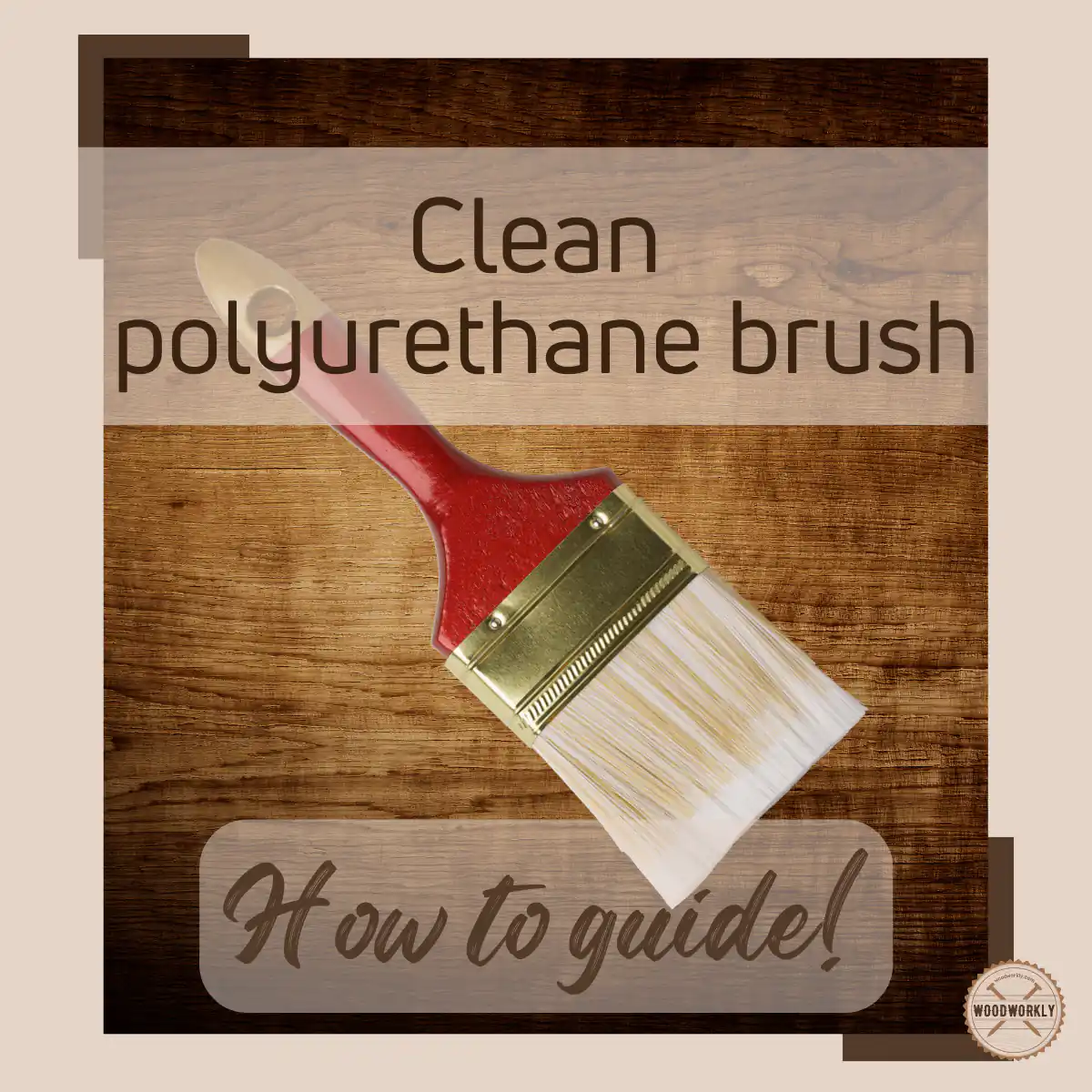
Putting on polyurethane takes a lot of cash, and I think it’s nice knowing that I may reuse certain supplies.
The brush may be used several times, unlike polyurethane, towels, mineral spirits, sandpaper, or tack cloths.
But that’s wasted cash if you aren’t sure how to clean polyurethane brushes. But relax; I’ll teach you how you can clean a polyurethane brush thoroughly with my many years of experience.
Here’s, How to clean polyurethane brush?
To clean a polyurethane brush, use water and soap for water-based brushes, or mineral spirits for oil-based ones. Rinse thoroughly under running water, then wash with soap, scrubbing gently with a nylon brush. Dry completely before storage.
But this was simply a quick look.
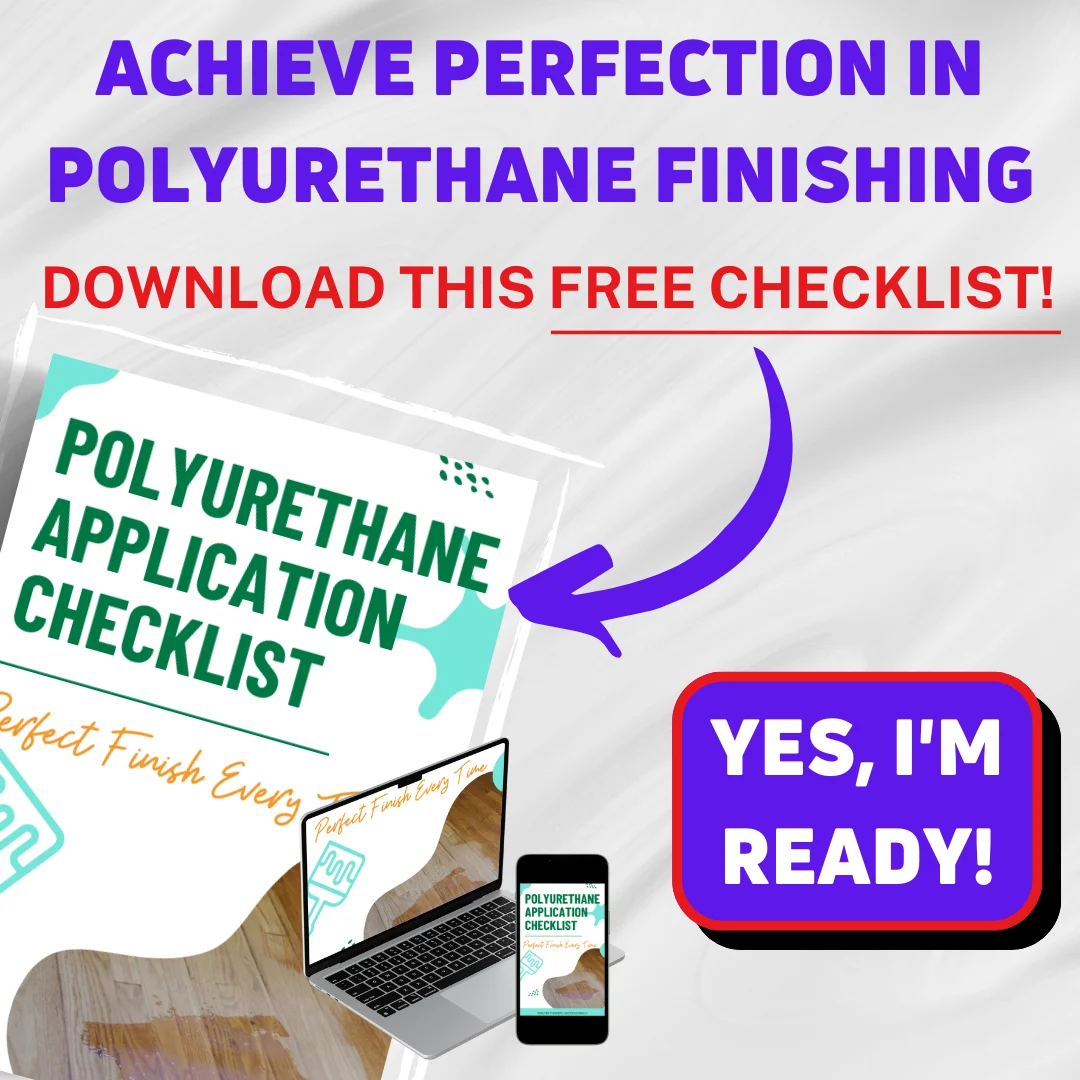
In this article, I’ll address any concerns you have about cleaning polyurethane brushes, like how to clean oil-based and water-based polyurethane brushes.
So, have the tools ready, and I’ll clean up!

Types of Polyurethane Brushes
You can employ two types of brushes for applying polyurethane as a coating for table tops or as a sealer on numerous wooden goods.
Natural Brushes
There are several types of brushes which are employed for applying polyurethane.
If you work with oil-based polyurethane, you need a brush with natural bristles.
Because they are crafted from hair from animals, they are better at soaking and applying oil coatings.
The issue with natural brushes remains that they’re very costly, so I advise you should take proper care of them.

Synthetic Brushes
Water-based coatings are most effectively used with brushes with synthetic bristles, typically synthetic nylon hairs.
This kind of brush does not take up a large amount of moisture, so it makes it the ideal brush for water-based polyurethane.
I think that synthetic bristles are far more flexible than natural bristles. They likewise offer an extra even finish and are affordable.
Read to know more about natural brushes vs. synthetic brushes.

Why You Should Clean Polyurethane Brushes
I believe that you need to clean your brush to maintain it in mint condition for a long time. When you use polyurethane, a little of it can remain on the brush.
When you fail to clean it immediately, the polyurethane can dry and firm on the brush.
As the polyurethane hardens, the drying process may lead the hair on the brush to wear.
In addition to having my equipment in decent condition; it additionally makes sure that my creations are of high quality.
Whatever the case may be if you’re applying water-based polyurethane or oil-based polyurethane, all you will need is a spotless polyurethane brush.

How to Clean Oil-Based Polyurethane from a Brush
The oil-based polyurethane brushes happen to be a lot filthier in comparison to synthetic brushes. However, the polyurethane brush is able to be cleaned in only a few minutes.
In my opinion, you should always wash your brushes while they’re still wet.
Allow me to teach you how simple it is to clean oil-based polyurethane brushes:
Here are the items you will need to clean oil-based polyurethane from a brush:
- Nylon scrub brush
- Running water
- Dish soap
- Gloves
- Three or four cups
- Mineral spirits, turpentine, or paint thinners
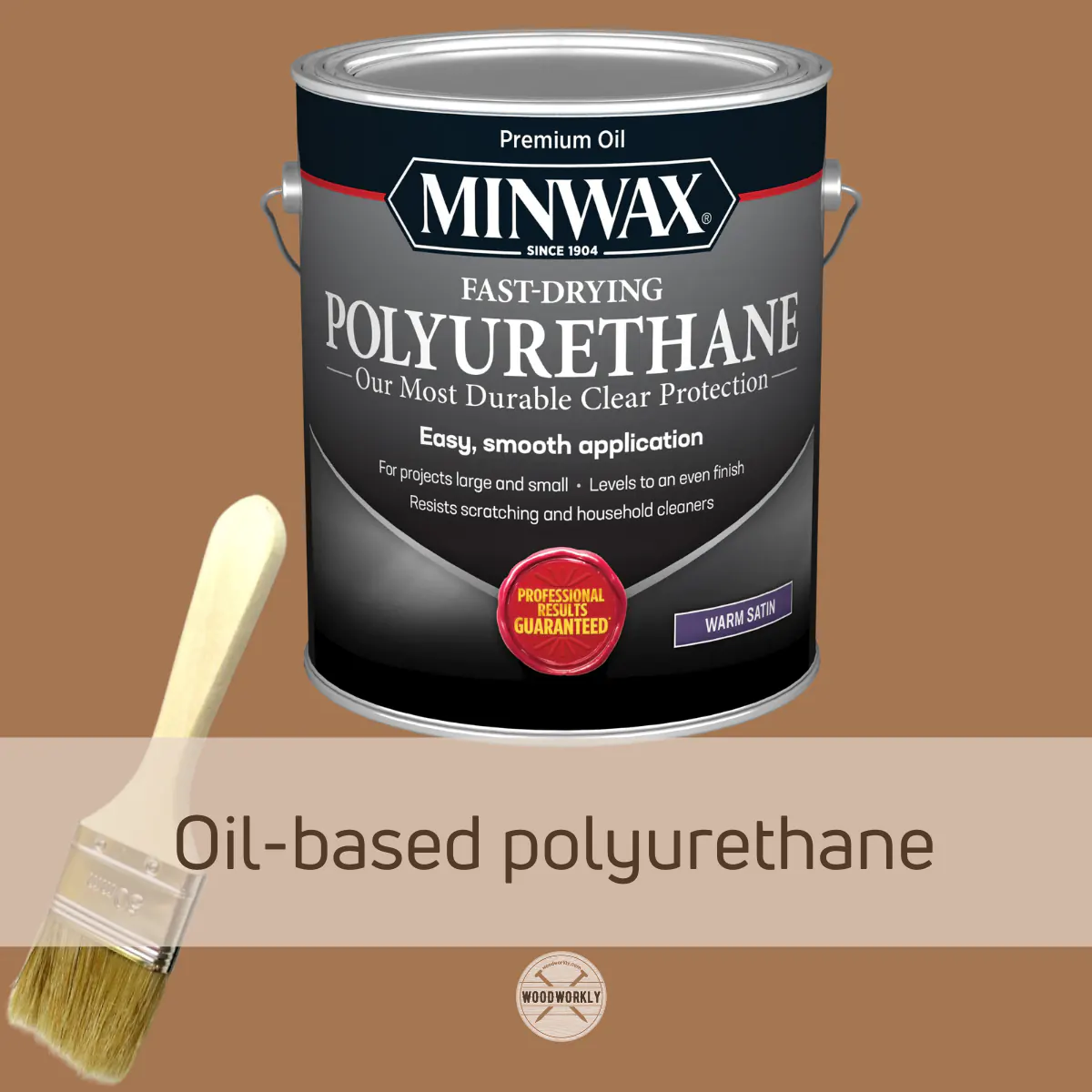
Here is the procedure you need to follow when cleaning oil-based polyurethane from a brush,
- Mineral spirits should be poured into three or four cups.
- The Brush should go in the first cup.
- Move on to a different cup.
- Scrub it using running water.
- Clean it with the nylon scrub brush.
- Let the Brush dry out.
Now I’ll give you more details about these steps.
1. Mineral Spirits Should Be Poured Into Three or Four Cups
Mineral spirits paint thinner, or oil should be poured into three or four cups.
As soon as the cups are full, I soak my brush all the way up to the end.
2. The Brush Should Go In the First Cup
Soak it in the mineral spirits in the first cup. I always hold my brush down to guarantee that every one of its bristles is soaking up the water.
After that, mix it inside the cup to move the mineral spirit into the spaces between the bristles.
3. Move On To a Different Cup
I suggest that you put the mineral spirits to a second cup shortly after the first one. Continue moving until the color of the water stops changing.
4. Scrub It Using Running Water
Carry the brush to the sink and wash it using fresh water running from the tap. I just scrub it using dish soap to make sure there aren’t any toxins remaining.
Do this again and again until you have a clear lather.
5. Clean It with the Nylon Scrub Brush
Place the brush into the sink once more, and the second time wash it with soap. I like to use a nylon brush to lightly brush it into the bristles to wash them.
Follow my steps until you have a polyurethane brush that is totally oil-free and perfectly clean.
6. Let the Brush Dry Out
Finally, I simply let it dry in the sink or another spot that is dry.
After an entire day, the brush is going to entirely dry.

How to Clean Water-Based Polyurethane from a Brush
The way to wash a brush that was used for applying water-based polyurethane is so easy that I feel it often gets ignored.
A short time is all needed to get your synthetic brush good to use.
These are the things you need to clean water-based polyurethane from a brush:
- Running water
- Gloves
- Dish Soap
- Two or three cups
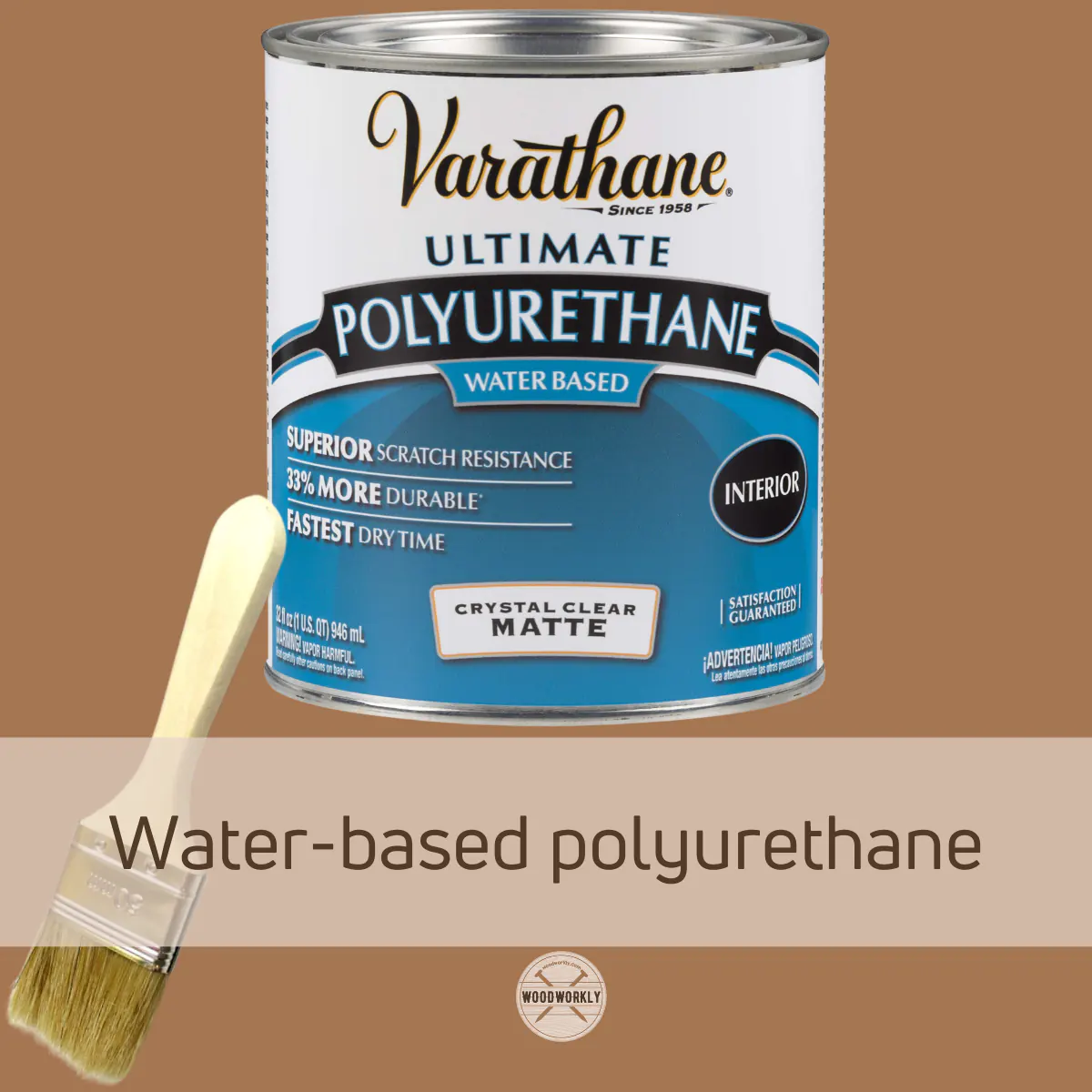
Here are the steps you need to follow when cleaning water-based polyurethane from a brush,
- Pour clean water into two or three cups.
- Place the brush into the water cup.
- Continue on to another clean cup of water.
- Use soap to clean the Brush.
- Put it up to dry.
Now I’ll explain these steps on how to clean polyurethane brush in detail.
1. Pour Clean Water into Two or Three Cups
I start by setting up three cups which are big enough to allow me to soak the brush up to the ferrule, the metal area that supports the bristles.
2. Place the Brush into the Water Cup
Place the brush in the first cup and move it back and forth to make sure the water goes between the bristles and reaches up to the handle. I do this a couple of times until the color of the water changes.
3. Continue On To another Clean Cup of Water
Continue on to the next cup of water if the water in the first one gets filthy. I usually continue doing this until the water in the last cup has become clear.
4. Use Soap to Clean the Brush
Go to the sink and allow the running water to flow over the brush to clean it. Afterwards, I put a little dish soap on it then give it an excellent scrub with my hands.
Wash it a minimum of two or three times, or until the brushes appear perfectly clean.
5. Put It Up To Dry
I normally either hang my brush over the sink or just place it up in my workshop.
The brush will have become fully dry by the next working day and is prepared for use once more.

How to Clean Polyurethane with Acetone
I sometimes clean my polyurethane brush using acetone.
Acetone is a typical paint thinner that is commonly applied to clean water-based polyurethane brushes as well as to get rid of oil-based polyurethane from synthetic bristles.
The items you will need to clean polyurethane with acetone:
- Gloves
- A wire brush
- Safety Goggles
- A piece of cloth or rag
- Acetone
- An empty container
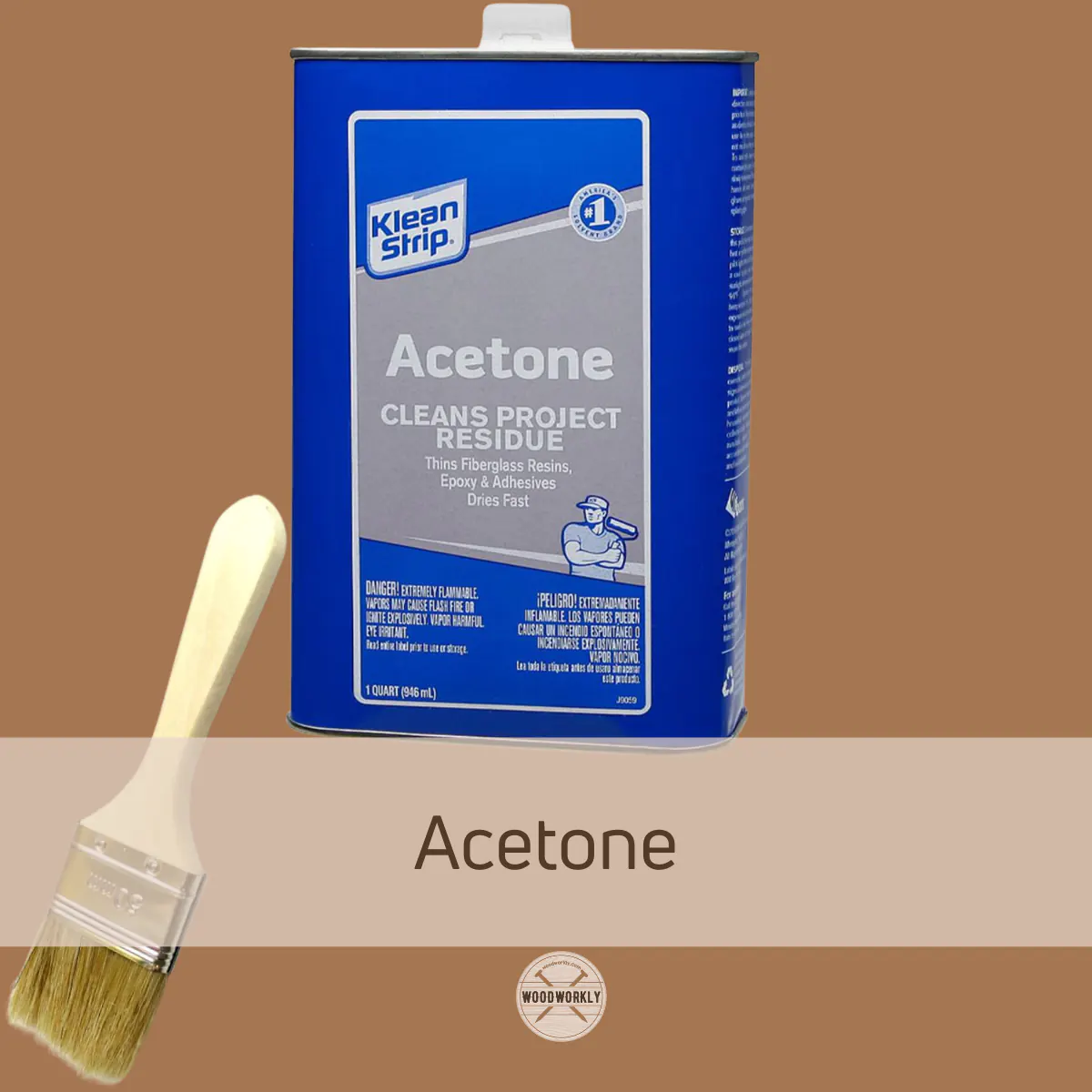
Here is the method you need to use when cleaning polyurethane with acetone,
- Safety comes first.
- Add the acetone.
- Dip and then soak the brush.
- Scrub the brush.
- Wash and dry.
- Reshape the bristles then store it.
So let me teach you all about the method I use to clean polyurethane with acetone.
1. Safety Comes First
I always shield my hands and eyes by wearing disposable gloves along with safety goggles.
I make sure that I’m working in a room with good ventilation or outside so that I’m not breathing in acetone chemicals.
2. Add the Acetone
I recommend that you only put a tiny amount of acetone into a small container.
3. Dip and Then Soak the Brush
Make sure all of the bristles of the polyurethane brush are covered by the acetone as you put it in.
I simply let the brush sit within the acetone for a good ten to fifteen minutes.
This is going to make the polyurethane on the brushes softer and easier to remove.
4. Scrub the Brush
When you complete soaking it, lightly scrub the bristles with a wire brush to get rid of any leftover polyurethane that is still there.
If you find remaining polyurethane on the brush, I suggest that you keep doing the soaking and cleaning steps till the brush is spotless.
5. Wash and Dry
Wash the brush completely with pure water to completely get rid of any leftover acetone that could still have been on it.
Then, I normally use a piece of cloth or rag for drying the brush.
6. Reshape the Bristles Then Store It
To avoid the bristles from getting bent, reshape the brush when it is remaining wet.
The freshly washed brush should be hung up or put away in an area that lets it dry fully.
Make sure it’s dry to the touch before putting it away to steer clear of harm or mold.
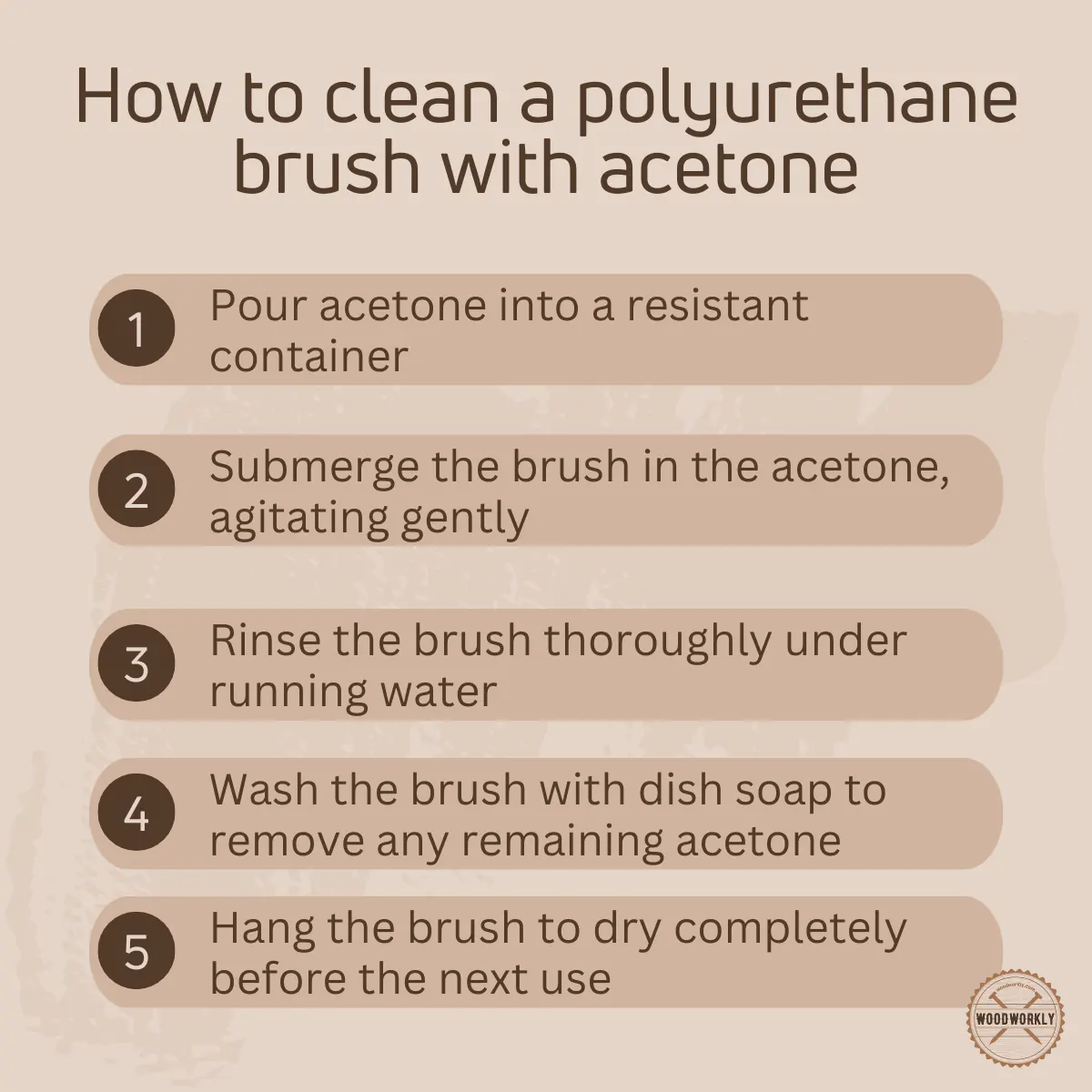
How to Clean Polyurethane with Mineral Spirits
Mineral spirit is commonly used to remove both water-based and oil-based polyurethane that remains on a brush.
Mineral spirits are powerful enough to get rid of oils and parts of the sealant.
Here is what you need to clean polyurethane with mineral spirits:
- A small container
- Gloves
- Mineral Spirits
- A wire brush
- A piece of cloth or rag
- Safety Goggles

This is the method I use to clean polyurethane with mineral spirits,
- Protection first
- Put mineral spirit.
- Dip and soak the brush.
- Scrub the brush and do it again if needed.
- Wash and let it dry.
- Shape the brushes and store them carefully.
Now I’ll teach you everything about the steps on cleaning polyurethane with mineral spirits.
1. Protection First
I always wear disposable gloves and face goggles to shield my hands and eyes. Avoid taking in mineral spirits fumes; be positive you’re working in a ventilated space or outside.
2. Put Mineral Spirit
I only put some mineral spirits to the container.
3. Dip and Soak the Brush
I usually check all the bristles of the polyurethane brush are soaked in the mineral spirits. Let the brush rest within the mineral spirits for 10–15 minutes.
It will loosen and eliminate the polyurethane that’s on the brush.
4. Scrub the Brush and Do It Again If Needed
Once soaking, I use a wire brush to lightly brush the bristles for the remaining polyurethane.
When there’s still polyurethane covering the brush, rinse it again and brush it again until it’s cleaned.
5. Wash and Let It Dry
Wash the brush well with water to get rid of all leftover mineral spirits. Afterward, I use a rag or cloth for drying the brush.
6. Shape the Brushes and Store Them Carefully
To keep the bristles from getting bent, I reshape the brush while it’s still wet.
Place the fresh brush or put it away in a way that lets it dry fully.
Make sure it’s totally dry before you put it away to stop damage.
Read to know How to use Mineral spirits!

Tips for Cleaning Polyurethane Brushes
Here are some of my best tips for cleaning polyurethane brushes,
- Proper Cleaning: I always clean polyurethane brushes immediately following use to stop hardening.
- Soak The Brushes: Dip the brushes in the solvent and soak. This weakens and destroys polyurethane.
- Use A Wire Brush: To remove polyurethane, I usually brush the bristles using wire brush after soaking.
- Dry Completely: Air-dry brushes or put them flat. Storage must be dry to avoid bristle harm or bending.
- Safely Store: I suggest you keep fresh brushes in a dry, cool location to keep their form and their resilience.
I believe cleaning a polyurethane brush saves money and is safer. This keeps your polyurethane brush for decades.
It maintains the equipment in excellent shape and maintains project quality. Whether water-based or oil-based polyurethane, a spotless brush is essential.
Read to know How To Fix Polyurethane Mistakes!
Congrats folks! Now you know exactly how to clean the polyurethane brush properly without messing this up.

So, let’s answer some frequently asked questions.
FAQs
What types of brushes are ideal for applying polyurethane?
Natural bristle brushes are best for oil-based polyurethane due to their capability to absorb and spread oil finishes evenly, whereas synthetic nylon brushes are more suited for water-based applications due to their resistance to moisture absorption.
Can the same brush be used for both water-based and oil-based polyurethane applications?
Yes, but for optimal results, it’s best to use natural brushes for oil-based applications and synthetic brushes for water-based ones, ensuring each brush is cleaned thoroughly between uses to maintain performance.
What is the significance of using a nylon scrub brush in the cleaning process?
Using a nylon scrub brush enhances the cleaning process by reaching between the bristles more effectively than using hands alone, ensuring a thorough clean and extending the life of your polyurethane brush.
Is it possible to use a roller instead of a brush for applying polyurethane?
Yes, rollers can be used for polyurethane application; foam rollers are recommended for smooth surfaces, and bristle brushes for textured surfaces to avoid potential damage during the application process.
Is it safe to reuse a polyurethane brush?
Yes, it is safe and economical to reuse a polyurethane brush. Ensuring that the brush is cleaned thoroughly after each use will maintain its integrity and readiness for future projects.
Why do you need to clean polyurethane brushes after every use?
Cleaning polyurethane brushes after every use is vital to maintain the quality of your work, prolong the life of the brushes, uphold a professional image, and protect your health from potential exposure to harmful VOCs present in polyurethane.
Is it okay to clean a polyurethane brush without water?
While cleaning with water is recommended, especially for water-based polyurethane, if you are dealing with oil-based polyurethane, you can start the cleaning process using mineral spirits or a similar solvent before a thorough wash with soap and water.
Can I clean a polyurethane brush without a thinning agent?
Yes, you can clean a polyurethane brush without a thinning agent, particularly when dealing with water-based polyurethane, by utilizing clean water and regular dish soap. For oil-based polyurethane brushes, the use of mineral spirits or turpentine followed by a soapy wash can be an effective cleaning method.
Did I cover all you wanted to know about: How to Clean Polyurethane Brush?
In this article, I explored how to clean polyurethane brush by taking both oil-based and water-based polyurethane. Plus, I’ve mentioned the general method of cleaning polyurethane brushes with acetone and mineral spirits.
To clean polyurethane brush, begin by cleaning water-based polyurethane brushes using clean water and mineral oil. Next, scrub the polyurethane brush thoroughly using a nylon brush with clean water. Lastly, hang the brush up for drying.
Furthermore, I’ve answered some frequently asked questions as well.
Hope you’ve learned everything you wanted to know about how to clean polyurethane brushes properly without making any mistakes.
So, it’s time to select the method that fits you the most based on your polyurethane type and keep your brush clean for another polyurethane round in the near future.